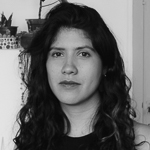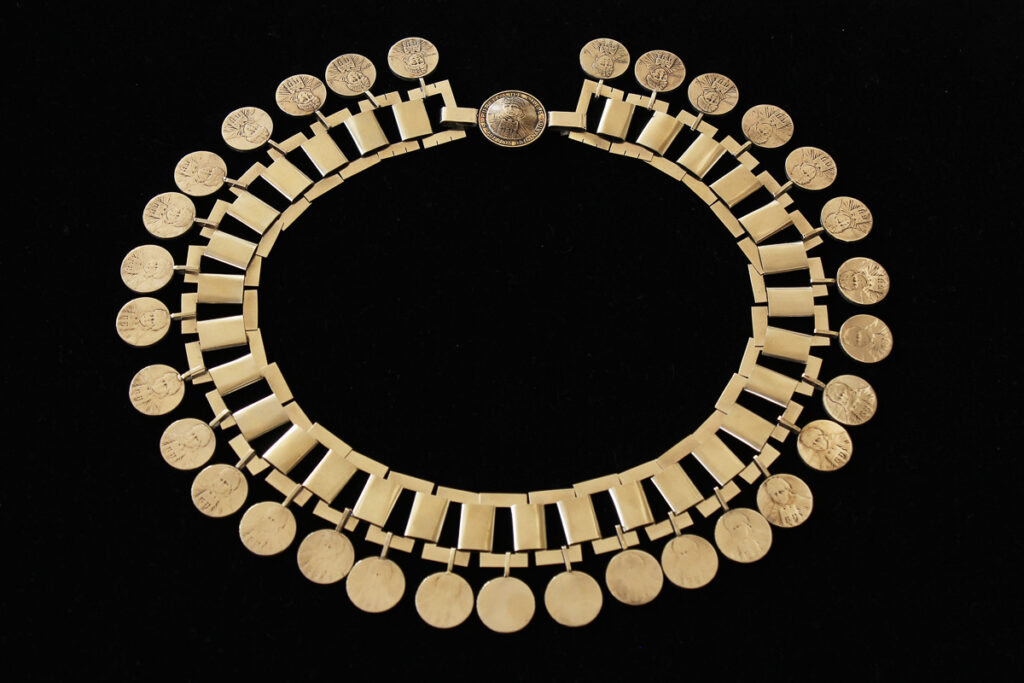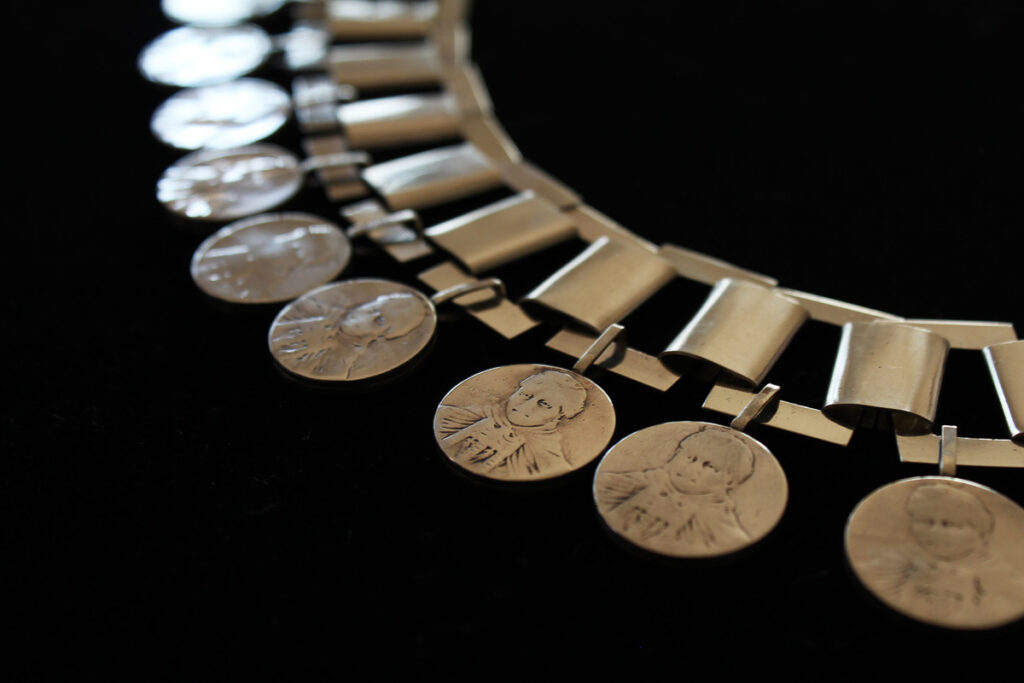- Milena Moena, Trarilonko de la serie Especies Acuñadas, año 2020, Metal, 26x23cm
- Milena Moena, Trarilonko de la serie Especies Acuñadas, año 2020, Metal, 26x23cm
- Milena Moena, Trarilonko de la serie Especies Acuñadas, año 2020, Metal, 26x23cm
Milena Moena Moreno seeks to deconstruct the symbolic capital associated with the colonisation of Mapuche in Chile.
As a capital city girl from an early age, I explored the city, its landscapes, architecture and, with that too, I saw the inequalities that it embodies.
I was born in Santiago de Chile, 1994. When I was little my father took me to tour the city, because we had the privilege of being able to move around by car and thus be able to attend different cultural events (concerts, plays, dance, open-air cinema, museums, etc) that the city provided.
From him, I acquired this interest in the arts. On the other hand, my mother, an artisan and teacher of the crafts (mosaic, decoupage and loom), taught me as a child through games and different ways of expressing myself such as painting, drawing, modelling and even mosaic. Later my stepfather would give me his knowledge and accompany me through the art world together, which would be a fundamental part of my critical vision.
After school, I decided to enter the School of Arts (2013-2016). I studied sculpture for a few years in goldsmithing. In the latter, I discover and have my first approach to working with metal. The technique captivated me, being able to understand the infinite possibilities and the language of it.
- Milena Moena, Trapelakucha de la serie Especies Acuñadas, año 2020, Metal, 27x14cm
- Milena Moena, Trapelakucha de la serie Especies Acuñadas, año 2020, Metal, 27x14cm
Once I graduated I specialised in jewellery, taking private classes (2107), where I learned to work in silver, thus having my first experiences designing and creating jewellery, from melting the metal to obtaining the final piece. After this, I decide to make a trip of more than six months through Andean America, travelling through Bolivia, Peru, Ecuador and Colombia. This trip is crucial in my personal growth; I had the fortune of being able to see infinite pre-Columbian art, meet jewellers, learn about stones and metals. These and more experiences make me appreciate above all the legacy delivered by our ancestors, being able to witness extraordinary metallurgical pieces together with the ancestral message that they carry. Back in Chile, I am interested in learning more about Mapuche jewellery and silverware, its history, understanding about its construction, its meanings, its imagination, etc.
From there, I have developed a work linked to jewellery and different visual languages, which lately focus on criticising the Chilean (neoliberal) social and economic model from a feminist position.
This position has been reinforced by the current context of mobilizations and social explosion (estallido social) that Chile has been experiencing for more than a year and which, as a consequence, had a plebiscite in which the majority of the people approved the execution of a new constitution to abolish the one executed under the dictatorship.
Among other things, we are demanding representation with parity not only of gender but also of indigenous peoples. In the streets, we support Mapuche demands because we have seen ourselves reflected in the violence, injustices and inequalities to which they have been subjected by governments.
Especies Acuñadas arises after working on my title project, called “The Body at the Service of Capital”. As its name indicates, this research reflects on and criticises the capitalist model. Especies Acuñadas is part of the fourth chapter and deals with the image of the original peoples — specifically the Mapuche people — that the powers have wanted to uphold, and how capitalism commercialises and benefits with its cultural imaginaries, in this case with the stereotypical image of the Mapuche woman, Machi (healer).
For the realisation of this series, I worked with coins of 100 Chilean pesos, issued in 2001 for the first time under the government of Ricardo Lagos 1.“Meanwhile, Lagos stressed that the vast majority of the 16 pro-Mapuche measures have been implemented over time and that this new $ 100 coin is one of them. “The delivery of this new coin symbolizes the desire to advance in the reunion with all ethnic groups and sectors,” said the President. ” Source: Emol.com, which on one of its faces contains the image of a Mapuche woman, with her traditional clothing and jewellery and the phrase “Republic of Chile · Native Peoples” and on the reverse the seal of the national shield.
Two realities of the same territory, the imposition of the construction of a homeland over the peoples that inhabit the territory, and the supposed attempt to pay homage to the Mapuche people by removing the body from its context, making it enter a currency, cash or species minted, capital flow.
The work consists of three pieces that recreate traditional Mapuche jewellery:
Trarilonko
Traditionally a chain was fitted to the head joining the ends on the nape. The links that formerly were a simple means of joining the plates, now have a visually leading role.
Chawaiearrings
The chawai are discoidal rings that may be large or small, smooth or with decorations and sometimes have crescent-shaped openwork. They are the oldest.
Trapelakucha (piece for the chest).
The trapelakucha is a self-supporting piece because it has its own clasp on the back of the upper plate. It is made up of three parts: a top plate cut out with curved designs representing two birds. This plate has three holes in its lower part, in which the three chains that join the upper plate are hooked. From this plate, they usually attach medals or anthropomorphic figures. It is one of the most used and popular jewellery within Mapuche women’s clothing (Magic Symbology in Mapuche Silverware, Providencia Cultural Institute exhibition catalog, Chile, 2011).
I make metaphoric use of the coins that have been valued as both productive and symbolic material for the elaboration of these pieces. I remove the image of the Mapuche woman placed on the coin, suppressing the identity and the body in all its forms. This loads it with a novel and exotic value.
If the arts are a mirror of society, this work is therefore subject to context. Through this imaginary, through visual language, I resignify the symbols and play with the political potential behind them. In this way, I participate in social demands, where I can speak out and continue the fight that many of us advocate.
Author

Milena Moena Moreno was born in Santiago de Chile, 1994. She came to the world of jewellery after having studied Plastic Arts (2013-2016). She specialised in goldsmithing. After graduation, she took private classes with Constanza Ramirez (2017). She combines her work as a jeweller with that of a visual artist.
Como capitalina/citadina desde muy temprana edad explore la ciudad, sus paisajes, arquitectura y, con eso también, vi las desigualdades que esta encarna. Nací en Santiago de Chile, 1994. De pequeña mi padre me llevaba a recorrer la ciudad, porque contábamos con el privilegio de poder movilizarnos en auto y así poder llegar a diferentes eventos culturales (conciertos, obras de teatro, danza, cine al aire libre, museos, etc) que la ciudad entregaba. De él adquirí este interés por las artes. Por otra parte al unísono mi madre artesana y profesora de las artesanías que crea (mosaico, decoupage y telar) me enseñaba de pequeña mediante juegos, diferentes formas de expresarme por medio de la pintura, el dibujo, el modelado e incluso el mosaico. Posteriormente mi padrastro me entregaría su conocimiento y transición por el mundo del arte en conjunto con historias de vidas, que serían parte fundamental de mi visión crítica.
Terminada la etapa escolar decidí entrar a la Escuela de Artes (2013-2016), Cursé unos años la especialidad de escultura y otros de orfebrería. En esta última descubro y tengo mi primer acercamiento al trabajo con el metal. La técnica me cautivó, el poder comprender las infinitas posibilidades y el lenguaje de esta. Una vez egresada es cuando me especializo en joyería, tomando clases particulares (2107), donde aprendí a trabajar el metal plata, teniendo así mis primeras experiencias diseñando y creando joyas, desde fundir el metal hasta obtener la pieza final. Posterior a esto, decido realizar un viaje de más de 6 meses por América Andina, transitando por Bolivia, Perú, Ecuador y Colombia. Este viaje es crucial en mi crecimiento personal; tuve la fortuna de poder ver infinito arte precolombino, conocer joyeros, aprender de piedras y metales. Estas y más experiencias me hacen apreciar por sobre manera el legado entregado por nuestros antepasados, el poder ser testigo de extraordinarias piezas metalúrgicas junto con el mensaje ancestral que estas portan. De regreso en Chile, vengo interesada en aprender más acerca de la joyería y de la platería mapuche, su historia, comprender acerca de su construcción, sus significados, imaginario, etc.
A partir de ahí, he desarrollado un trabajo vinculado a la joyería y a diferentes leguajes visuales, los que últimamente se centran en la crítica al modelo social y económico chileno (neoliberal) desde una posición feminista.
Esta postura se ha visto reforzada por el actual contexto de movilizaciones y estallido social que se encuentra viviendo Chile desde hace más de un año y que tuvo, como consecuencia, un plebiscito en donde el pueblo en su mayoría aprobó la ejecución de una nueva constitución para abolir la ejecutada bajo dictadura.
Entre otras cosas, estamos exigiendo representatividad con paridad no sólo de género, sino que también de pueblos originarios, en las calles apoyamos las demandas mapuche porque nos hemos visto reflejados en la violencia, injusticias y desigualdades a las que han sido sometidos por los gobiernos.
Es así como surge Especies Acuñadas, luego de trabajar en torno a mi proyecto de título, llamado “El Cuerpo al Servicio de El Capital“; tal como su nombre lo indica esta investigación reflexiona y critica el modelo capitalista. Especies Acuñadas es parte del cuarto capítulo y trata sobre la imagen de los pueblos originarios—específicamente del pueblo mapuche— que los poderes han querido instalar, y cómo el capitalismo mercantiliza y usufructa con sus imaginarios culturales, en este caso con la imagen estereotipada de la mujer mapuche, Machi1.
Para la realización de esta obra trabajé con monedas de 100 pesos chilenos, emitida el año 2001 por primera vez bajo el gobierno de Ricardo Lagos2, la cual en una de sus caras contiene la imagen de una mujer mapuche, con su vestimenta y joyeria tradicional, con la frase “Republica de Chile · Pueblos Originarios” y al reverso el sello del escudo nacional. Dos realidades de un mismo territorio, la imposición de la construcción de patria por sobre los pueblos que habitan el territorio, y el supuesto intento de homenajear al pueblo mapuche sacando al cuerpo de su contexto, haciéndolo ingresar en una moneda de cambio, numerario o especie acuñada, flujo de capital.
La obra se compone de tres piezas que recrean la joyería tradicional mapuche: 1. Trarilonko3 (pieza para la cabeza) 2. Chawai4 (aros) y 3. Trapelakucha5 (pieza para el pecho). Metaforizo haciendo uso de las monedas que han sido ocupadas como material tanto productivo como simbólico para la elaboración de estas piezas. Haciendo desaparecer y omitiendo la imagen de la mujer mapuche puesta en la moneda, suprimiendo la identidad y el cuerpo en todas sus formas. Cargándola de un valor novedoso y/o exotico.
Si el artes es espejo de la sociedad, esta obra por ende, se encuentra sujeta al contexto. A través de este imaginario, por medio del lenguaje visual resignifico los símbolos y juego con el potencial político que hay detrás de ellos. De esta manera me hago partícipe de las demandas sociales, donde puedo sacar la voz y continuar con la lucha por la que muches abogamos.
Notes
- Machi
- m. y f. Chile. En la cultura mapuche, curandero de oficio, especialmente cuando es mujer.https://dle.rae.es/machi ↩
- “En tanto, Lagos destacó que la gran mayoría de las 16 medidas pro pueblo mapuche se han ido implementando en el tiempo, y que esta nueva moneda de $ 100 es una de ellas. <>, comentó el Primer Mandatario.” Fuente: Emol.com – http://www.emol.com/noticias/economia/2001/12/14/73860/presentan-nueva-moneda-de–100-con-imagen-de-mujer-mapuche.html ↩
- Es una cadena, presente también en la trapelakucha. Tradicionalmente el trarilonko se ceñía a la cabeza uniendo los extremos sobre la nuca. Los eslabones que antiguamente eran un simple medio de unión de las placas, pasan a tener un papel visualmente protagónico. ↩
- Los chawai son aros discoidales que pueden ser grandes o pequeños, lisos o con decoraciones y en ocasiones presentan calados con forma de medialuna. Son los más antiguos. ↩
- La trapelakucha es una pieza autoportante porque lleva su propio broche al dorso de la placa superior. Está compuesta de tres partes: una placa superior recortada con diseños curvos que representa dos aves. Esta placa tiene tres orificios en su parte inferior, en los cuales se enganchan las tres cadenas que se unen la placa superior. De esta placa peen, por lo general, medallas o figuras antropomorfas. Es una de las joyas más usada y popular dentro de la indumentaria femenina mapuche. Fuente: Simbología mágica en la Platería Mapuche, Catálogo exposición Instituto Cultural de Providencia, Chile, 2011. ↩
Related stories
References
| ↑1 | “Meanwhile, Lagos stressed that the vast majority of the 16 pro-Mapuche measures have been implemented over time and that this new $ 100 coin is one of them. “The delivery of this new coin symbolizes the desire to advance in the reunion with all ethnic groups and sectors,” said the President. ” Source: Emol.com |
|---|








Comments
Destruir o enterar monedas en curso es legal?
Destruir o alterar, monedas en curso es legal?